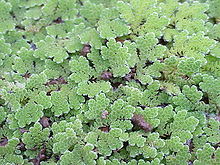Algae ferns
| Algae ferns | ||||||||||||
|---|---|---|---|---|---|---|---|---|---|---|---|---|

Large algae fern ( Azolla filiculoides ) |
||||||||||||
| Systematics | ||||||||||||
|
||||||||||||
| Scientific name | ||||||||||||
| Azolla | ||||||||||||
| Lam. |
The plant genus Azolla ( Azolla ) belongs to the family of salviniaceae (Salviniaceae). The seven or so species thrive in freshwater in the tropics .
description
Algae fern species are 0.5 to 15 centimeters tall, herbaceous plants that float on the surface of the water . They spread through runners and can overgrow the water surface over large areas. Their root hairs reach down a few centimeters, but are not anchored in the ground.
Ecology, use and control
Algae ferns only occur in stagnant or slow-flowing waters. The algae ferns have nitrogen-fixing cyanobacteria ( Anabaena azollae , Nostoc azollae ) in their leaf hollows. This symbiosis is used in rice cultivation : Azolla grows with the rice fields and, after composting, contributes to the nitrogen supply . In addition, dense growth of azolla prevents the development of many mosquito species , which is beneficial in areas where malaria occurs.
Algae ferns are used as ornamental plants in garden ponds or aquariums . They have spread to many parts of the world. In some cases they have developed into a “ weed ”. In Germany, this applies to the species Azolla filiculoides , which is listed as a "naturalized neophyte" by the Federal Agency for Nature Conservation. The weevil Stenopelmus rufinasus is successfully used for biological control .
It is believed that a “bloom” of a species of algae fern that had occurred repeatedly over several hundred thousand years in the Arctic removed a great deal of carbon dioxide from the atmosphere . This Azolla event caused the earth to cool significantly in the Eocene 49 million years ago and the global climate was transferred from a warm period to the ice age that still exists today, with constant glaciation at both poles.



Systematics
The genus Azolla was established by Jean-Baptiste de Lamarck . The genus name Azolla is derived from Greek words azo drought and ollyo for killing off this refers to the death of the Algenfarns in dry Previously they were in their own family Algenfarngewächse (Azollaceae Wettstein provided).
The genus Azolla includes the following five to seven species:
Ancient species
- Nile algae fern ( Azolla nilotica Decne. Ex Mett. ): It occurs in eastern Africa .
-
Feathered algae fern ( Azolla pinnata R.Br. ): There are subspecies:
- Azolla pinnata subsp. africana ( Desv. ) RMKSaunders & K.Fowler : It is widespread in tropical and southern Africa and in Madagascar.
- Azolla pinnata subsp. asiatica ( Desv. ) RMKSaunders & K.Fowler : It occurs in China, Japan, India, Pakistan, Nepal, Sri Lanka, Bangladesh, Thailand, Myanmar, Vietnam, Indonesia, the Philippines and New Guinea.
- Azolla pinnata R.Br. subsp. pinnata : It occurs in Australia and New Caledonia and is a neophyte in Florida.
- Azolla rubra R.Br. : It occurs in Australia and New Zealand.
Newworldly species
- Small algae fern ( Azolla caroliniana Willd. ): It is native to North, Central and South America and on the Caribbean islands. It is a neophyte in some countries in Europe and South Asia .
-
Large algae fern ( Azolla filiculoides Lam. , Syn .: Azolla japonica Franch. & Sav. ), With the following subspecies:
- Azolla filiculoides subsp. cristata ( Kaulf. ) Fraser-Jenk. (Syn .: Azolla cristata Kaulf. , Azolla mexicana Schlecht. & Cham. ): It is originally found in Argentina and Paraguay .
- Azolla filiculoides Lam. subsp. filiculoides : It is widespread in North, Central and South America and Australia. It is a neophyte in many countries in Europe , Asia and Africa.
- Azolla microphylla Kaulf. : It is common in North , Central and South America and on the Caribbean islands. It occurs as a neophyte in southern Africa.
swell
literature
- Alan R. Smith, Kathleen M. Pryer, Eric Schuettpelz, Petra Korall, Harald Schneider, Paul G. Wolf: A classification for extant ferns. In: Taxon. Volume 55, No. 3, 2006, ISSN 0040-0262 , pp. 705-731 ( abstract, PDF file ).
Individual evidence
- ↑ Christel Kasselmann : aquarium plants. Ulmer Verlag, Stuttgart 1995; 2nd, revised and expanded edition 1999, ISBN 3-8001-7454-5 , pp. 137–140.
- ↑ Azolla filiculoides Lam., Large algae fern. In: FloraWeb.de.
- ↑ Christel Kasselmann: aquarium plants. 1999, p. 137.
- ↑ Michael Hassler, Bernd Schmitt: World Ferns. Checklist of Ferns and Lycophytes of the World. Version 5.4.1, September 2015. Azolla (enter in search mask). Karlsruhe 2015.
- ↑ a b c d e Azolla in the Germplasm Resources Information Network (GRIN), USDA , ARS , National Genetic Resources Program. National Germplasm Resources Laboratory, Beltsville, Maryland. Retrieved February 22, 2019.